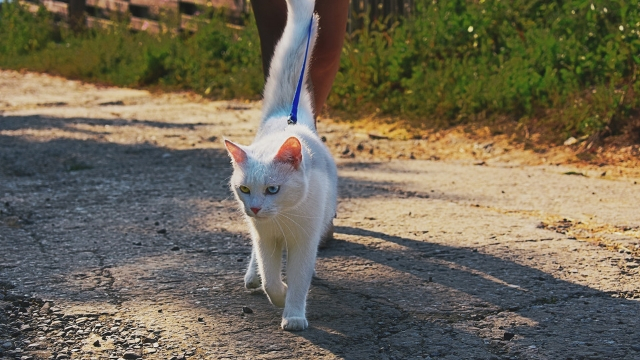Exercising is fundamental to keep our felines in shape. You know those extra pounds your kitty gained because he’s always eating and sleeping won’t go away on their own and they might take a toll on his health. Strangely enough, when it comes to keeping felines active, the suggestions we get are always related with funny cat games or toys to keep them entertained and running. Unlike dogs, walking cats never shows up as a possibility to keep our companions in shape. ? Why is that? Is it the absence of cat parks? Society’s expectations? Well, try to put a leash on your cat and you’ll quickly understand why.
Why aren’t cats usually walked with a leash?
The reason is quite simple: they don’t like it. ? Unlike dogs, cats kept their wild side, even after domestication. They still have the mentality of a hunter and they still have their sense of independence very present.
By putting a leash on a cat, we are restraining his movements, leaving the feline distressed as he lost his own sense of control. He can no longer flee or hide if he encounters something scary or frightening nor can he prepare an attack or a pounce freely and cunningly as he likes.
Walking cats is not a thing because due to this distress, felines will likely try to escape the leash harming themselves and whoever is close to them in the process.
Can they be taught?
It is a slow process, but yes, they can.
You should start as soon as possible teaching your kitten to accustom him to all the stimulation he can get outdoors. The cat should already have a trusting relationship with you, though, so he feels safe in having you calling the shots and protecting him.
Get him a cat harness and let your feline smell it and check it. You can give him some treats while at that so he starts having a positive association with it. In the following days, try to drape he harness loosely. It might take a while, but once he feels comfortable with the loosened harness and with you putting it on him, slowly start to tighten it to fit snugly. Always pet your pal, talk in a soothing voice or give him treats whenever the harness is involved so he starts thinking of it as fun times. If he struggles with the harness, just remove it and try again later.
Once the cat is comfortable wearing the harness even in his normal day activities, attach the leash and let him drag it around to get used to its weight. The next step will be you holding the leash while he explores the house. Let yourself be guided by the cat and not the other way around, but every now and then try to call him and give him a treat when he responds. ? After the cat is comfortable walking on a leash indoors, taking him outside, small steps at a time so he can grow familiar with his new surroundings before taking him out for longer walks.
Is it good for them?

Opinions diverge on this point.
Most professionals suggest walking cats is a good activity to keep them in shape and healthy both physically and mentally. They are curious animals and true explorers that can benefit from having new places to discover and from receiving new stimuli outside their comfort zone (a.k.a. your apartment). It is also a chance to reinforce the bond between owner and cat. ?
However, the Royal Society for the Prevention of Cruelty to Animals (RSPCA), a non-profit organization based in the UK, advices against walking cats arguing that it is more likely to stress them and disrupt their behavior than to bring advantages. According to this organization, cats can have enough stimuli indoors, provided you give them enough toys and opportunities for them to play.
Other things to consider
Adjust your expectations: cats are different from dogs, so you should adjust your expectations accordingly. Don’t expect your pal to walk side-by-side with you or even a steady walk at that. He might be wearing a harness, but your cat is still his own master. ?
-
- Don’t leave the cat alone: if you need to pop up at a store, better to do it another time or choose one that accepts pets. Never tie your cat outside alone while waiting or he might freak out.
-
- Prefer a harness instead of a single collar: even if the collar is well adjusted, it can come out or harm your cat’s throat if he gets suddenly scared and tries to flee.
-
- Choose peaceful areas to walk the cat and try to avoid any encounter with dogs or even school kids.
- Monitor his mood: as soon as you detect any mood change in your pal, it’s better to end the walking session. If he gets scared or angry, the leash and the outdoors stimuli will only make it worse.
Unlike dogs that love spending time with us and play outdoors, walking cats comes with its pros can cons. Regardless where you stand on the matter if it’s good to walk felines or not, you should always keep in mind your cat’s personality. If he is adventurous and naturally active and social, you can give it a go, but don’t force an aloof cat into doing something he doesn’t want to or is afraid of. Taking a stroll should be pleasant for both you and Mr. Whiskers. If one part is not having fun, it’s better to be creative and play some games at home to keep your pet in shape. ?






